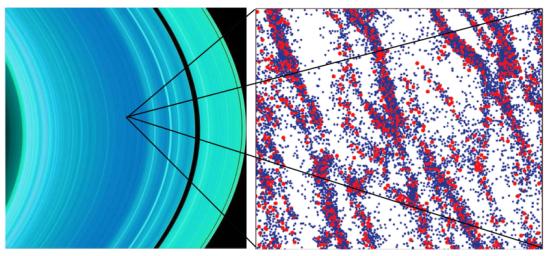
|
Clumps in the A Ring
- Click the image above for a larger view
- Full-Res JPEG (2385 x 1111) (388.4 kB)
- Full-Res TIFF (2385 x 1111) (8.0 MB)
Caption:
The left image is a false-color view of Saturn's A ring from the ultraviolet imaging spectrograph instrument aboard the Cassini spacecraft.
The ring is the bluest in the center, where the gravitational clumps are the largest. The thickest black band in the ring is the Enke Gap, and the thin black band further to the right is the Keeler Gap.
The right image is a computer simulation about 150 meters (490 feet) across illustrating a clumpy region of particles in the A ring. The particles are moving counterclockwise, from bottom to top.
Background Info:
The Cassini-Huygens mission is a cooperative project of NASA, the European Space Agency and the Italian Space Agency. The Jet Propulsion Laboratory, a division of the California Institute of Technology in Pasadena, manages the mission for NASA's Science Mission Directorate, Washington, D.C. The Cassini orbiter was designed, developed and assembled at JPL. The ultraviolet imaging spectrograph was built at, and the team is based at the University of Colorado, Boulder.
For more information about the Cassini-Huygens mission visit http://saturn.jpl.nasa.gov . The ultraviolet imaging spectrograph team home page is at http://lasp.colorado.edu/cassini .
Cataloging Keywords:
| Name | Value | Additional Values |
|---|---|---|
| Target | Saturn Rings | A Ring |
| System | Saturn | |
| Target Type | Ring | |
| Mission | Cassini-Huygens | |
| Instrument Host | Cassini Orbiter | |
| Host Type | Orbiter | |
| Instrument | Ultraviolet Imaging Spectrometer (UVIS) | |
| Detector | ||
| Extra Keywords | Clump, Color, Gap, Ultraviolet | |
| Acquisition Date | ||
| Release Date | 2005-09-05 | |
| Date in Caption | ||
| Image Credit | NASA/JPL/University of Colorado | |
| Source | photojournal.jpl.nasa.gov/catalog/PIA03556 | |
| Identifier | PIA03556 | |
